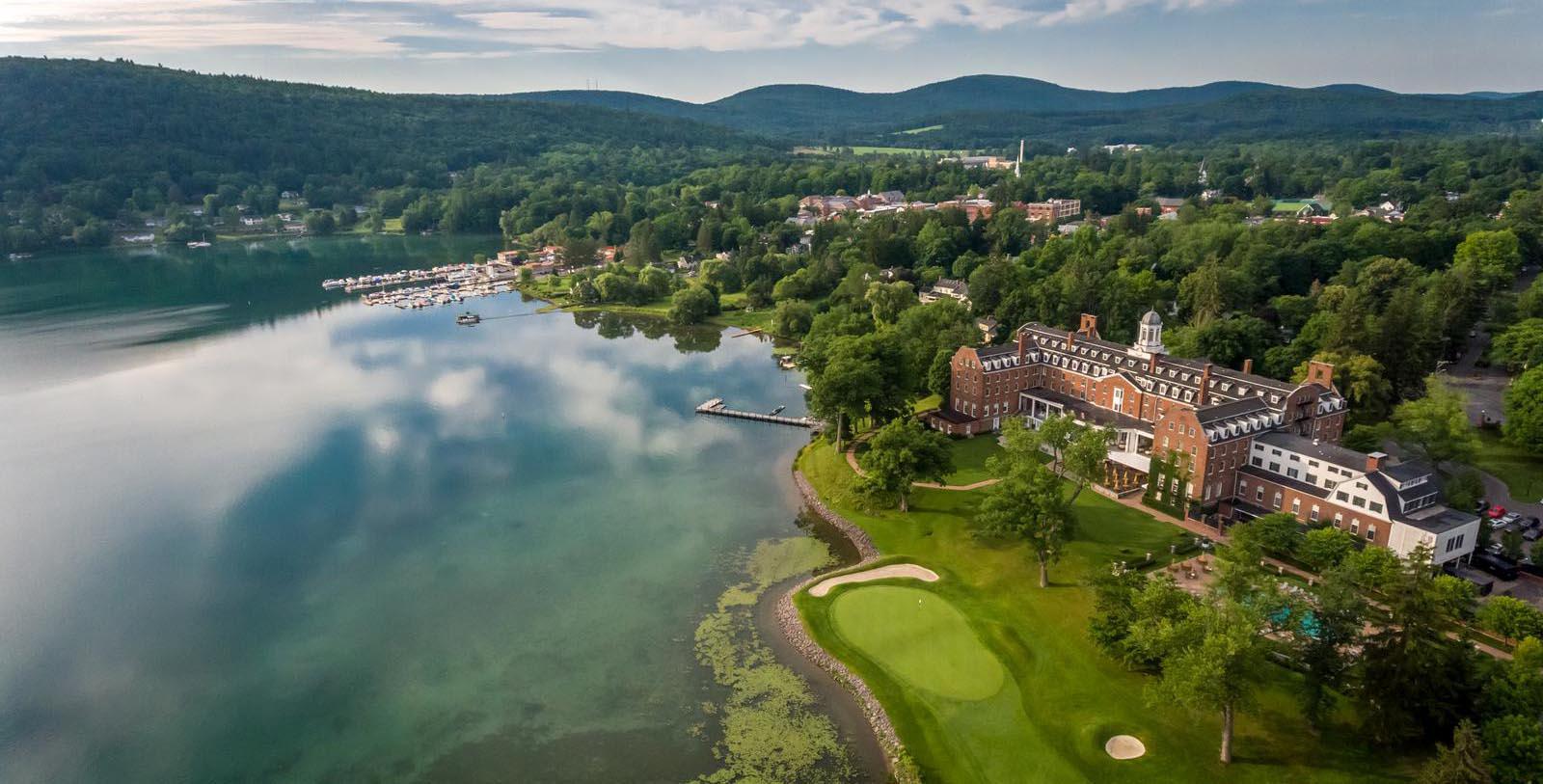Receive for Free - Discover & Explore eNewsletter monthly with advance notice of special offers, packages, and insider savings from 10% - 30% off Best Available Rates at selected hotels.
cooperstown, ny, hotel golf course
Discover the Leatherstocking Golf Course, which was designed by noted golf course architect Devereux Emmet.
Considered one of the East Coast’s most scenic golf courses, Leatherstocking Golf Course sweeps along the southern shore of Lake Otsego in Cooperstown, New York. Renowned architect Devereux Emmet originally designed the course at the behest of Stephen and Edward Clark, who were in the middle of developing The Otesaga Hotel. Indeed, the two brothers had hoped Emmet’s golf course would serve as the crown jewel to their even greater lakeside resort. The choice to select Emmet reflected that desire, as he was a revered name throughout the world of golf. Emmet managed to craft a stunning nine-hole golf course that immediately gained national praise upon its debut in 1909. In fact, its popularity reached such heights that the Clark family hired Emmet to return and construct another nine holes a decade later. Visiting golfers marveled at its challenging layout—a practice that Emmet had adopted from his mentor, Charles B. Macdonald. Many of the final holes had actually reflected similar ones featured at the Garden City Golf Club, which Emmet had designed earlier in his career. As with Garden City, the fairways rolled in various directions with deceptive slants that faded into well-hidden hazards. Some courses proved to be so intricate in their formatting that Emmet rated them as par fives. Perhaps his most iconic par five was the 18th hole, which ended on an imposing island green. He also placed smaller holes throughout the course as well, although they remained just as complex. While the par-three 17th hole cut for a mere 195 yards, the build-up toward the green required the player to shoot directly over deep water! The course has remained true to its historical roots, with the Cooperstown, NY, hotel taking great pains to protect its legendary character over the years. The work succeeded in attracting throngs of golfers for generations ever since. Among the most noteworthy have been National Baseball Hall of Fame inductees like Ty Cobb and Babe Ruth, who have frequented Cooperstown regularly. In fact, Leatherstocking has even hosted annual golf tournaments for the former players during the Major League Baseball Hall of Fame induction weekend!
-
About the Location +
The Otesaga Hotel is a contributing structure within the federally recognized Cooperstown Historic District. Located in the center of Cooperstown, the district is comprised of more than 230 historic structures. The area itself resides within the original settlement of Cooperstown, New York, which was first developed as a village by Judge William Cooper in 1785. Cooper was a prominent politician during America’s early republican years, serving as both a local judge for the Court of Common Pleas, as well as a Federalist member of the U.S. House of Representatives. He had come to acquire the land directly from Colonel George Croghan, a failed land speculator who had regularly worked with various Native America tribes on the frontier of Pennsylvania and Ohio. (Many tribes associated with the Iroquois Confederacy lived in the area for many centuries prior.) Covering a total land mass of some 10,000 acres, Cooper specifically selected the bottom of Otsego Lake as the site for a small settlement. Called “Cooperstown,” Cooper’s little community grew steadily over the next few years to number a couple hundred people. Cooper soon became one of the town’s most influential individuals, often dictating the temperament of local politics and carrying himself as a pseudo-aristocrat. He also raised a family alongside his wife, Elizabeth Fenimore, raising a total of 12 children throughout his lifetime. Perhaps the most accomplished of his offspring was James Fenimore Cooper, who rose to become one of the nation’s preeminent authors of historically themed novels. Most of James’ work was shaped by Cooperstown itself, particularly its many gorgeous natural landmarks. He even gave Otsego Lake its celebrated nickname of “Glimmerglass.”
Cooperstown evolved into a resort community over the next several decades, as families from across the Northeast and Mid-Atlantic traveled north to enjoy the serenity of Otsego Lake. Its transformation into a popular vacation retreat was further solidified when the Clark family—led by brothers Stephen Carlton and Edward Severin—decided to open a luxurious waterfront resort hotel in 1909. (The Clarks were themselves were the heirs to the fortune generated by the Singer Manufacturing Company, known today as the Singer Corporation.) Stephen Carlton Clark took special interest in Cooperstown’s future, especially as a picturesque holiday destination. Among the many projects that Clark pursued was the creation of the National Baseball Hall of Fame during the 1930s. With the Great Depression desolating the local economy, Stephen Carlton Clark devised a number of ways to further incentive tourism to Cooperstown. Due to the recent rise of baseball as the national pastime, Clark constructed a magnificent facility that would celebrate the sport’s heritage. He fully financed the building’s construction and dedicated the structure in June of 1939. Clark ingeniously marketed the institution’s role in preserving the legacy of baseball, which quickly attracted thousands of people from across the nation. However, he occasionally exaggerated the sport’s history throughout his marketing campaigns in order to build interest. In fact, it was Clark who erroneously claimed that Union Civil War hero Abner Doubleday invented the game while fighting in the conflict! Cooperstown has since remained one of the best destinations to visit in all of New York, offering the opportunity for hours of entertainment.
-
About the Architect +
Devereux Emmet: A renowned figure in golf history, Devereux Emmet was both an accomplished golf course architect and amateur player. He first discovered the game during a trip to Scotland, where he explored the verdant fairways of the historic North Berwick Golf Club. Emmet the began practicing golf regularly afterward, despite having a lucrative career in law. Over time, Emmet became one of the most accomplished golfers on the amateur circuit, eventually entering—and reaching—the quarter finals at the 1904 Amateur Championship. But Emmet had also started dabbling in golf course architecture upon establishing a friendship with the great Charles B. Macdonald. In fact, Emmet had actually helped Macdonald create the National Golf Links of America. While on another vacation in the United Kingdom, Emmet had specifically visited several historic courses and sketched them at Macdonald’s request. The latter then took those drawings and incorporated them into his greater designs. But the journey also gave Emmet the inspiration to construct his own golf course. In 1897, he finally got his chance when his father-in-law asked that he develop a nine-hole facility that would complement a planned village set to debut on Long Island. Originally known as the “Island Golf Links,” Emmet gradually expanded the complex to feature a full complement of 18-holes two years later. The newly christened “Garden City Golf Club” immediately endeared itself among countless golfers, who were amazed at its gorgeous layout. Indeed, the Garden City Golf Club’s format was so impressive that it wound up hosting the U.S. Open in 1902. Emmet’s work on the club subsequently solidified his emerging reputation as a golf course architect. Nevertheless, he decided to form a design firm with Alfred Tull to obtain even more projects. A former construction supervisor under both Walter Travis and A.W. Tillinghast, Tull’s presence proved to be a boon for Emmet. The partnership went on to design many courses, including the renowned Wheatley Hill Golf Club. When Devereux finally died in 1934, he had clearly left an indelible mark upon the world of golf.
-
Famous Historic Golfers +
Babe Ruth, outfielder for the New York Yankees that is regarded as being the best baseball player in the sport’s history.
Ty Cobb, outfielder for the Detroit Tigers remembered for setting 90 Major League Baseball records during his career.
































